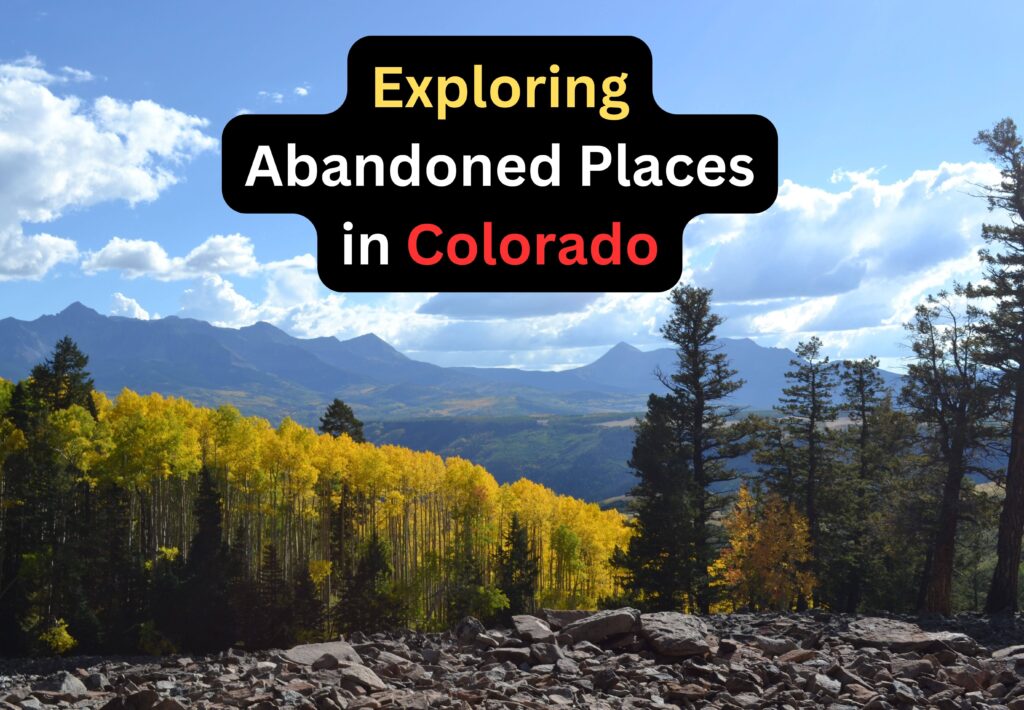Snowy peaks of Colorado
The state of Colorado, renowned for its snowy peaks, vibrant landscapes, and bustling cities.Colorado’s abandoned places has a rich and varied history that intertwines with the narrative of abandonment. The tale begins in the mid-19th century when Colorado was gripped by gold fever. Thousands flocked to the state in search of fortune, leading to the establishment of numerous mining settlements. These settlements thrived as long as the gold flowed, but when the veins ran dry, so did the streams of wealth-seekers. The inhabitants left in search of new opportunities, leaving behind the ghost towns that Colorado is so famous for today.
Colorado's narrative of abandonment
Industrial progress, too, plays a role in Colorado’s narrative of abandonment. As industries evolved and transportation improved, many railway stations and factories faced obsolescence. Left in the wake of progress, these original structures and industrial relics now stand as silent witnesses to a bygone era.
Natural disasters have also contributed to the abandonment of areas within Colorado. Major floods, landslides, and wildfires have forced residents to evacuate, often leaving towns and neighborhoods uninhabitable.
This journey through Colorado’s abandoned places offers Urban Explorer more than just an exploration of forgotten landscapes; it provides a portal through time, helping us to understand the history of Original Buildings in Colorado and the forces that have shaped it.
Colorado's Famous abandoned places
In the following sections, we will delve deeper into the stories of these abandoned places, one by one, uncovering their historical significance and the reasons for their desertion. These places have a variety of fascination for curious explorers.
1. Aloysius Chapel – Central City
The original structure of Aloysius located in Central City, an old mining town that was once known as “the richest square mile on Earth,” sits the abandoned St. Aloysius Chapel. This Gothic-style chapel was built in 1867 to serve the Catholic community of miners and their families. However, as mining in the area dwindled, so did the population. The last service held in the chapel was in 1947, and it has been abandoned ever since. Today, visitors can explore the dilapidated interior of the chapel and get a glimpse into its past.
2. Buckhorn Exchange – Denver
In Denver’s oldest neighborhood, sits an iconic restaurant with a decades-long history. The Buckhorn Exchange, which opened in 1893, was once a popular spot for cowboys, miners, and even Buffalo Bill himself. However, with the decline of Denver’s livestock industry, the restaurant eventually closed its doors in 2018. Today, visitors can still see the old neon sign hanging outside and get a glimpse of Colorado’s historic past.
3. Crystal Mill – Marble
It is Located in the town of Marble, Colorado, the Crystal Mill is a picturesque abandoned mill that has become an iconic landmark. Built in 1892, the mill was used to power air compressors at a nearby silver mine. However, after the mine closed in 1917, the mill was left deserted. Today, it serves as a popular spot for photographers and hikers, who can reach the mill via a scenic 4×4 trail.
4. Ghost Town of St. Elmo – Nathrop
The deserted town of St. Elmo, located near Nathrop, Colorado, was once a bustling mining community in the late 1800s to early 1900s. However, when the mines closed in the 1920s, so did the town. Today, St. Elmo is considered one of the best-preserved ghost towns in the state, with several well-maintained buildings and homes that visitors can explore.
5. Animas Forks – San Juan Mountains
High up in the San Juan Mountains sits the abandoned mining town of Animas Forks. Established in the late 1800s, this town was home to over 30 historic buildings and a bustling population of miners and their families. However, as mining declined, so did the town’s population. By the early 1920s, Animas Forks was completely abandoned. Today, visitors can explore the well-preserved structures and Pacific Railroad to get a glimpse into its past.
6. Abandoned Farmhouse – Keota
Farmhouse Located in the small town of Keota, Colorado, this abandoned farmhouse is a hauntingly beautiful sight. The home was originally owned by a family of homesteaders who settled in the area in the early 1900s. However, as the population dwindled and farming became less viable, the family eventually left their home and moved on. Today, the original building of the house stands as a reminder of Colorado’s history and the hardships early settlers faced.
7. Swetsville Zoo – Fort Collins
The Swetsville Zoo in Fort Collins is not your typical zoo. It doesn’t have any living animals at all. Instead, it’s an outdoor sculpture garden filled with metal sculptures made from recycled materials. The zoo was created by Bill Swets, an eccentric artist who also built his home and wooden structure on the property. However, after he died in 2002, the property fell into abandonment and disrepair. Today, visitors can still see the unique sculptures but should be aware that some areas are closed off due to safety concerns.
8. Swetsville Zoo – Fort Collins
Estate park Known for its role in the movie “The Shining”, The Stanley Hotel in Estes Park is a popular tourist destination. However, not many people know that there is a dilapidated structure abandoned concert hall located on the property. The concert hall was built in 1909 and hosted famous performers such as Duke Ellington and John Philip Sousa. However, after a devastating fire in 1911, the hall was abandoned and left to decay. Visitors can still catch a glimpse of this piece of history while wandering through the hotel’s grounds.
9. Ghost Town Museum – Colorado Springs
Colorado Springs although not a traditional “abandoned” place, the Ghost Town Museum in Colorado Springs is a unique attraction that showcases various structures and artifacts from old ghost towns around Colorado. The museum features an indoor exhibit as well as outdoor displays, allowing visitors to experience what life was like in these abandoned towns. Some of the structures even come from famous ghost towns such as St. Elmo and Animas Forks.
10. Animas Forks – Silverton
Animas Forks was once a bustling mining town during the late 1800s. It is Located high in the San Juan Mountains. However, as the mines were depleted and people began to leave, the town was eventually abandoned in the early 1920s. Today, visitors can see remnants of the once-thriving town, including a few preserved central city buildings and mining equipment. The town has been designated as a National Historic Site and is open to the public for exploration.
11. Gold Belt Tour – Cripple Creek
The Gold Belt Tour is a scenic drive through some of Colorado’s most historic towns, paved roads, and sheep mountain including Cripple Creek, Victor, and Florence. Along the route, visitors can see abandoned mines and ghost towns that were once booming during the state’s gold rush in the late 1800s. The tour also includes a stop at the Mollie Kathleen Gold Mine, one of the only remaining fully operational gold mines in the state.
Conclusion:
Urban exploration has become a popular activity for curious explorers throughout the United States. Colorado houses an array of dilapidated buildings, each carrying a unique narrative of the state’s vibrant past. From enduring remnants of ghost towns like St. Elmo and Cripple Creek to the thought-provoking exhibits of the Ghost Town Museum. Abandoned places in colorado offer a captivating glance into history. Whether you are a history enthusiast, a thrill-seeker, or an explorer, the allure of these places promises a journey through time that is both insightful and fascinating.

